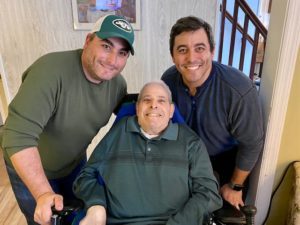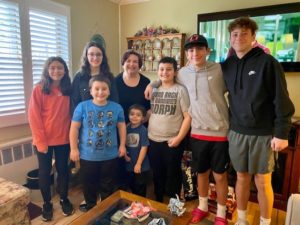In Part 1 of our interview with Lorrie and Stewart Altman, we discussed the journey to the Late-onset Tay-Sachs disease (LOTS) diagnosis, how Lorrie and Stewart’s outlook shaped their lives, and funny stories from Stewart’s working days. Today, we are discussing advocacy, the family dynamic, and how to best find a support system.
LOTS & Advocacy
1994 – the year that marked the “official” LOTS diagnosis. Of course, Stewart had already been diagnosed years before. But in 1994, a doctor called the Altman family to talk about how they could meet other people through a Foundation for patients with Late-Onset Tay-Sachs disease. At first, Lorrie says, she was confused:
“Nobody had ever mentioned the word ‘Tay-Sachs’ to us. We never knew that it was the same thing.”
Visiting their first conference in Boston, however, was an eye-opening experience. Lorrie and Stewart met other people who talked and walked just like Stewart – others who needed to make a fist and push on their arms to stand up. They made many friends through the Foundation, including a couple whose son was diagnosed at age 12. When the Foundation closed down, Lorrie and Stewart joined the National Tay-Sachs and Allied Diseases Association.

In 2005, Stewart was asked to speak to a group of doctors at a conference to discuss the challenges of living with LOTS. Through this, Lorrie and Stewart met more close friends, Brian and Sherri, whose family was touched by infantile Tay-Sachs disease. These lifelong friends lost one child to infantile Tay-Sachs disease but, through in vitro treatment, have two children now without. Lorrie, Stewart, Brian, and Sherri have had a ton of fun together – especially at Yankee Stadium, where they watched the Yankees play the Red Sox.
The Family Dynamic
As everything else was happening, Lorrie and Stewart were also raising a family. The pair always tried to go to every baseball game, hockey game, or parent-teacher conference they could. While Stewart was unable to go at points due to the stairs, Lorrie explains that the schools were very accommodating, always rearranging meetings where they could to ensure that Stewart could attend. When I asked how they explained LOTS to their children, Lorrie says:
“We said that Daddy walks funny, that he had a disease but they weren’t going to get it. All of our children are carriers.”
She also explains that the family loved (and still loves) going to amusement parks with Stewart, as he can carry everything for them and they are able to go to the front of the line.
When their son Russell was a teenager, he told his parents that he wanted to study physical therapy. Lorrie and Stewart believe this had to do with LOTS, as physical therapy can delay some of the symptoms or at least halt disease progression.

After both Civi and Kien retired, the family got a new dog, Chipper, who still lives with them today. Since Stewart is retired, Chipper helps him around the house. Lorrie considers Chipper to be part of the team, alongside Rich. In 2010, Lorrie explains:
“I was having trouble moving Stewart even with a transfer board. We found Rich, who came to help me every night. After he lost a place to live, he just moved in with us. Now he’s been here for 10 years. He’s become part of the family, sometimes an annoying part…”
She pauses. I hear a laugh on the call; Rich is also in the room. With a chuckle, Lorrie proceeds:
“Stewart and Rich like each other. They pick on each other, they laugh. He’s a godsend and very proud of what he does to help keep Stewart moving forward. Everywhere we go, it’s the three of us and the dog. A very unusual family, but it works for us!”
Multiple Myeloma Diagnosis
Five years ago, Rich was moving Stewart when he heard a loud crack. At first, everyone thought maybe he had dislocated Stewart’s shoulder. But after pursuing medical care, it turned out that Stewart’s right humerus had snapped in half. The orthopedic surgeon didn’t like the look of the break, so ran some tests. This resulted in a diagnosis of multiple myeloma, a cancer of the bone marrow. Ever since, Stewart has been undergoing chemotherapy every Monday (3 weeks on, 1 week off).
Prior to the cancer, Stewart took part in a clinical trial for LOTS but did not do well on that medication, rapidly losing weight and experiencing gastrointestinal issues. While his multiple myeloma makes him ineligible for newer trials, both he and Lorrie hope that more treatment options are discovered.
Finding a Support System
Currently, Lorrie and Stewart rely on friends and family for support. Lorrie also frequently speaks with new members from the National Tay-Sachs and Allied Diseases Association. She explains:
“The Association has an unbelievable network and they can put you in touch with anything or anybody you need.”
Through this, she has helped families across the nation. Lorrie tells one story about a man whose wife left him following his diagnosis. With his parents unable to take care of him, he was placed into a nursing home in his 50s. After reconnecting with his former girlfriend on Facebook, she took him out of the nursing home; they got married, and she now cares for him. She and Lorrie sometimes speak, but Lorrie is so thankful that she can provide support to those in need.
COVID-19 has been particularly tough on Stewart and Lorrie, especially as chemotherapy makes Stewart immunocompromised. During this time, they frequently spoke to their children and grandchildren via FaceTime. However, this past December, the family was able to safely gather for a Hanukkah party.

In the end, Lorrie says, their ability to roll with life’s challenges hinges on their positive attitude. She shares:
“Stewart tells jokes and thinks things are funny. He’s had his moments but we’ve all had our moments. He’s a human being and he has other problems. There’s a point when I had to catheterize him 3x a day for three months. He screamed while I did it, but we did it. We handle what we have to handle, and we don’t dwell on things.”
Finally, to those who are newly diagnosed or who have a family member who is newly diagnosed, Lorrie tells them that there is help available. That they can call her and she’ll answer any questions. She and Stewart leave everyone with a reminder:
“It’s not a death sentence. Stewart is 69 years old and was diagnosed at 26. He’s still with us. You have to take care of yourself, but you can live a full life.”






